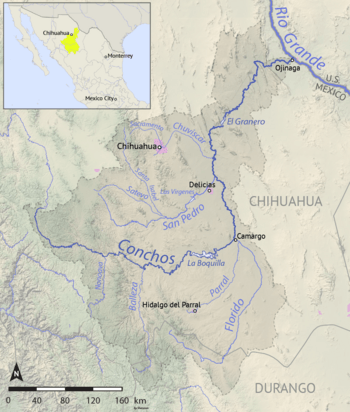Rio Conchos facts for kids
Quick facts for kids Río Conchos |
|
|---|---|

Map of the Conchos
|
|

Map of the Rio Grande watershed, showing the Rio Conchos joining the Rio Grande near Ojinaga.
|
|
| Country | Mexico |
| State | Chihuahua (state) |
| Physical characteristics | |
| Main source | Sierra Madre Occidental Guadalupe, Chihuahua |
| River mouth | Rio Grande Ojinaga, Chihuahua 29°35′N 104°25′W / 29.583°N 104.417°W |
| Length | 560 km (350 mi) |
| Basin features | |
| Basin size | 68,400 km2 (26,400 sq mi) |
The Río Conchos (also called the Conchos River) is a big river in the Mexican state of Chihuahua. It flows into the Río Bravo del Norte. The Rio Grande is a famous river that forms part of the border between Mexico and the United States. The Conchos River joins the Rio Grande near the town of Ojinaga, Chihuahua.
Contents
About the Conchos River
The Río Conchos is the most important river in Chihuahua. It is also the largest river that flows into the Rio Grande. This makes it a very important river system in northern Mexico.
The Conchos River has several large reservoirs (human-made lakes). These reservoirs hold water for farms and to make electricity. Making electricity from water is called hydropower.
Where the River Flows
The Conchos River starts high up in the Sierra Madre Occidental mountains. This is in a place called Bocoyna, Chihuahua. From there, it flows east and many smaller rivers join it. These smaller rivers are called tributaries.
Dams and Lakes
As the river flows, it reaches the Valle de Zaragoza area. Here, it is stopped by the La Boquilla Dam. This is the biggest dam in Chihuahua. It creates a large lake called Toronto Lake.
After Toronto Lake, the river continues east. It forms another lake called Colina Lake. Then, it flows through Camargo, Chihuahua. This area is a major farming center. Here, the Florido River joins the Conchos.
Journey to the Rio Grande
From Camargo, the Conchos River turns north. Near Delicias, Chihuahua, the San Pedro River joins it. The Conchos then enters the Chihuahuan Desert. It cuts a path through the desert before turning northeast.
Near Aldama, Chihuahua, the river is dammed again by the Presa El Granero. After this, it flows through a narrow passage called the Peguis Canyon. Finally, it forms one last dam, Toribio Ortega, near Ojinaga. At Ojinaga, the Conchos River proudly joins the mighty Rio Bravo (Rio Grande).
Amazing River Life
The Río Conchos is very special for its wildlife. The World Wide Fund for Nature (WWF) has listed it as a "Global 200 Freshwater Ecoregion." This means the WWF thinks it's one of the most important places on Earth for freshwater biodiversity. Biodiversity means all the different kinds of life in an area.
Unique Animals
The WWF says the Conchos River has "globally outstanding" unique life. It is also in danger, so it needs urgent help. The Conchos River is the only large river in the Rio Grande area that still flows freely. This means it hasn't been changed much by humans.
Its river and spring areas are mostly natural. They are home to many fish that live nowhere else. For example, 12 out of 47 native fish species are endemic to this river. This means they are found only here. Also, 12 out of 46 native herpetofauna (reptiles and amphibians) species are endemic.
Why It's Special
This amazing variety of life has survived because the river's natural flow hasn't been changed. People haven't built many walls or changed its path. The Conchos region is important not just for its river life. It also has special springs and caves. These places help many unique species live there.
However, the river faces some challenges. Pollution from factories and sewage can harm it. Farm waste and too many animals eating plants (overgrazing) also cause problems. Sometimes, new types of plants or animals (exotic species) are brought in, which can hurt the native ones. Poor land management, like cutting down too many trees near the river, also causes damage.
See also
 In Spanish: Río Conchos para niños
In Spanish: Río Conchos para niños

